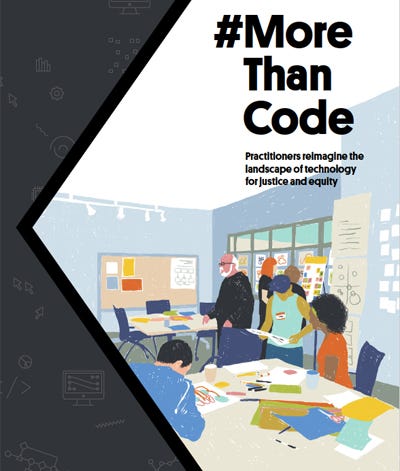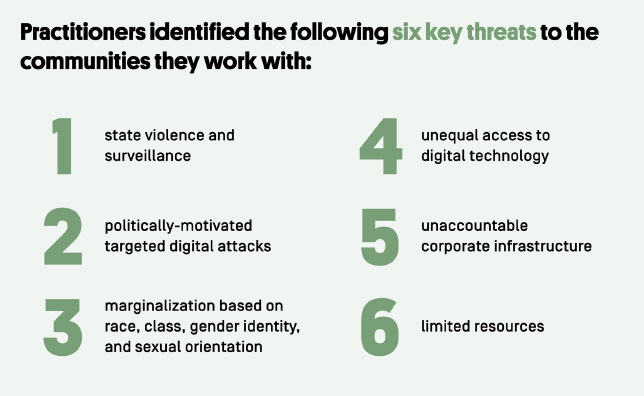Lessons from the #More Than Code Report

Earlier this year, the Technology for Social Justice Field Scan surveyed workers at the nexus of technology and the public interest in order to better understand the needs in this ecosystem of practice—one which intersects with that of digital and immersive storytelling.
How diverse are different related fields? What are the barriers to entry? How can systems be changed to better reflect community needs? Where are public interest projects most effective? #More Than Code: Practitioners reimagine the landscape of technology for justice and equity provides a sketch of the state of the space and where it needs to go.
Using a combination of interviews and focus groups, #More than Code draws on the collective experience of civic technologists, community organizers, designers, data specialists, and others who use technology in service to the public.
The report offers many insights and recommendations for improving such work. Here’s a sample of those takeaways, along with a few selected quotes from practitioners. You can read the full report here.
Adopting Co-Design Methods and Concrete Community Accountability Measures
Tech project design must involve people from the communities the project is meant to serve, early on, and throughout the design process. We recommend that practitioners from all sectors:
1. Adopt co-design methods. Most crucially, tech projects should be grounded in real-world community needs and be led by or include organizations with deep domain knowledge. These methods have a growing practitioner base but could be better documented.
The struggle is not ‘access to encryption tools.’ It is organizing day labor communities in order to protect against ICE raids, and things like that. We’re confusing means and ends… [Technologists] pretend like technology is the thing that matters, when it’s actually people’s fight that matters and the outcome that matters.” — Gertruda, digital security researcher
2. Develop and adhere to specific, concrete mechanisms for community accountability. For example, funders and municipalities might prefer or require tech projects to present a concrete community accountability plan across all stages of design, testing, and implementation.
3. Invest in education (both formal and informal) that teaches co-design methods to more practitioners. Support existing efforts in this space, create new ones, and push existing educational programs and institutions to adopt co-design perspective and practices.
I didn’t study technology in school. I didn’t go to school for tech. I did English and women’s studies. I’ve had very little formal tech education. Almost all of my learning has been on the job.” — Matija, worker/owner at a tech cooperative
4. Create tech clinics modeled on legal clinics. Public interest law and legal services work are client-oriented, and lawyers doing this work are constantly interacting with and learning from people who need to navigate larger systems. Tech can learn from this model.
5. Do real usability testing, and create community research and design groups. Usability testing is essential to validate assumptions and create usable UX and UI. For broader oversight, set up Community Design Boards for technology design projects, similar to Community Review Boards for research projects.
“One group tried to make [a self-assessment tool] for elderly people for iPad. It completely failed. Someone did a brochure for the same project, and it was much more successful. That just stuck in my mind, because technology isn’t always the right solution. We don’t have to always make an app for it.” — Tivoli, freelancer and UX research at a tech corporation

6. Create fellowships to spread co-design methods across multiple fields, not only in tech, but in other areas as well, such as legal services.
7. Avoid “parachuting” technologists into communities. Instead, prioritize resourcing people from the community to build their tech skills. This doesn’t mean “no outsiders can help a community,” but projects with outside support work best when they help develop community capacity to take over, maintain, and grow the project in the long run.
Funders fly in to communities of color and basically tell them, this is how things should be done. We disagree. There are people within the communities already with knowledge who are not being lifted up. If we’re really going to build power, we need to build power in the communities…. There’s only a handful of funders now that are focusing on building capacity.” — Charley, executive director at a technology nonprofit.
8. Stop reinventing the wheel. Allocate increased resources for capacity building, maintenance, and improved usability of existing proven tech, not just pilots of new tools.
With Ingress (an AR mobile game) and Open 311, most of the stops are in affluent neighborhoods. Similarly, with Fix My Street, people who have smartphones are building that map. If we’re not paying attention to the inequalities in these tools, they are going to be even more entrenched.” — Hardy, technology capacity builder and crisis response specialist
For the full report, visit #More Than Code.
#More Than Code was produced by the Tech for Social Justice Project, co-led by Research Action Design (RAD) and the Open Technology Institute at New America (OTI), together with research partners Upturn, Media Mobilizing Project, Coworker.org, Hack the Hood, May First/People Link, Palante Technology Cooperative, Vulpine Blue, and The Engine Room. NetGain, the Ford Foundation, Mozilla, Code For America, and OTI funded and advised the project.
Spread the word! This excerpt is licensed under a Creative Commons ShareAlike 4.0 International License, the same license as the original report.
Immerse is an initiative of the MIT Open DocLab and The Fledgling Fund, and it receives funding from Just Films | Ford Foundation and the MacArthur Foundation. IFP is our fiscal sponsor. Learn more about our project here.